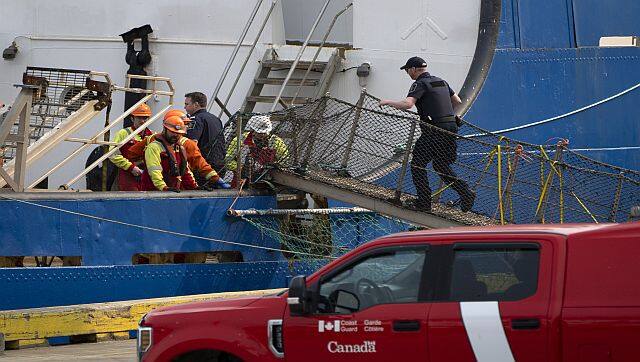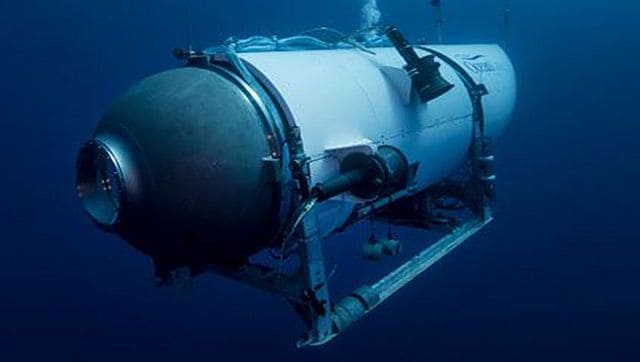A submersible with five people had vanished on a tour of the Titanic wreckage off the coast of Newfoundland, Canada, on 18 June. From Sunday to Thursday, the Coast Guard coordinated a multinational search and rescue effort that ended with an announcement that the crew was believed to have died in a “
catastrophic implosion.
” A multi-national “unified command” of ships, aircraft, deep sea diving equipment, and troops from the governments of the United States, Canada, France, and the United Kingdom spent hours and incalculable millions of dollars on the search and rescue mission. Now comes the debate over who should foot the bill for the hunt for wealthy risk takers. The massive Titan search and rescue operation The official search for the Titan submersible began on 19 June, when it lost contact about an hour and 45 minutes after submerging with a 96-hour oxygen supply. In the subsequent search, aircraft from different part of the world were deployed to find the missing. The United States mobilised the Coast Guard and employed three US Army C-17 transport planes, as well as an aquatic drone capable of showing what is 20,000 feet underwater, more than 6,000 metres, and providing clear photographs, reports AS news. [caption id=“attachment_12789392” align=“alignnone” width=“640”] Authorities from the US and Canada began the process of investigating the cause of the fatal Titan submersible implosion even as they grappled with questions of who was responsible for determining how the tragedy unfolded. AP[/caption] Canada contributed to the operation with a patrol plane and two surface boats, one of which had doctors specialised in diving medicine that arrived on the scene on Thursday. Lastly, France also joined the search by contributing a ship equipped with a remotely operated vehicle called the Victor6000. Cost of the operation Although the US Coast Guard refuses to disclose a cost estimate for its efforts to locate the Titan, The Washington Post published a conservative estimate of $1.2 million (Rs 9.8 crore) based on publicly available information and interviews with government officers. In a statement to The New York Times, Chris Boyer, the executive director of the National Association for Search and Rescue, indicated that the cost of the operation would probably reach several million dollars at the very least.
Also Read: Why Titanic tourism draws people in despite dangers
This estimate takes into account a variety of elements, including fuel costs for the several vehicles involved in the operation, vehicle maintenance requirements, and the investment in staff responsible for operating the equipment. Additionally, the Canadian government is continuing to carry out an investigation into the incident to determine whether any laws were broken that would warrant a criminal investigation into the company leading the trip. Payment for the operation It is unclear who will pay the bill, but in the short term, taxpayers are likely to bear the significant financial burden of the rescue attempt. [caption id=“attachment_12789402” align=“alignnone” width=“640”]
Authorities from the US and Canada began the process of investigating the cause of the fatal Titan submersible implosion even as they grappled with questions of who was responsible for determining how the tragedy unfolded. AP[/caption] Canada contributed to the operation with a patrol plane and two surface boats, one of which had doctors specialised in diving medicine that arrived on the scene on Thursday. Lastly, France also joined the search by contributing a ship equipped with a remotely operated vehicle called the Victor6000. Cost of the operation Although the US Coast Guard refuses to disclose a cost estimate for its efforts to locate the Titan, The Washington Post published a conservative estimate of $1.2 million (Rs 9.8 crore) based on publicly available information and interviews with government officers. In a statement to The New York Times, Chris Boyer, the executive director of the National Association for Search and Rescue, indicated that the cost of the operation would probably reach several million dollars at the very least.
Also Read: Why Titanic tourism draws people in despite dangers
This estimate takes into account a variety of elements, including fuel costs for the several vehicles involved in the operation, vehicle maintenance requirements, and the investment in staff responsible for operating the equipment. Additionally, the Canadian government is continuing to carry out an investigation into the incident to determine whether any laws were broken that would warrant a criminal investigation into the company leading the trip. Payment for the operation It is unclear who will pay the bill, but in the short term, taxpayers are likely to bear the significant financial burden of the rescue attempt. [caption id=“attachment_12789402” align=“alignnone” width=“640”] The official search for the Titan submersible began on 19 June, when it lost contact about an hour and 45 minutes after submerging with a 96-hour oxygen supply. AP[/caption] As a matter of Homeland Security policy and the law, the Coast Guard never asks a private company or individual to reimburse the government for the costs associated with search and rescue missions, according to the Coast Guard. “The Coast Guard, as a matter of both law and policy, does not seek to recover the costs associated with Search and Rescue from the recipients of those services,” according to a report in Yahoo News. “As a matter of law, 46 USC 2110(a)(5) prohibits the Coast Guard from collecting fees for the conduct of SAR operations: The Secretary may not collect a fee or charge under this subsection for any search or rescue service.”
Also Read: What’s the Titanic sub, which charges Rs 2.02 cr for expedition, that has vanished?
According to retired Admiral Paul Zukunft, in an interview with The Washington Post, OceanGate, the company responsible for conducting voyages to the Titanic wreckage, is not expected to reimburse the US government. The ex-head of the US Coast Guard expressed: “It’s no different than if a private citizen goes out and his boat sinks. We go out and recover him. We don’t stick them with the bill after the fact.” Moreover, even if the individuals involved in the initial expedition had obtained some form of insurance, it is believed that such coverage would be insufficient to offset the expenses incurred by the Coast Guard’s extensive efforts. Boyer further commented that he anticipates the question of responsibility for funding rescue missions to become increasingly significant as private expeditions venture into space and delve into ever deeper seas. A spokesperson for the National Park Service, Cynthia Hernandez, mentioned that they never charge for any rescue mission because it is a public service. Cynthia further stated that in case the budget crosses the limit, NPS funds might pay for the operation. With inputs from agencies Read all the Latest News
, Trending News
, Cricket News
, Bollywood News
, India News
and Entertainment News
here. Follow us on
Facebook
,
Twitter
and
Instagram
.
The official search for the Titan submersible began on 19 June, when it lost contact about an hour and 45 minutes after submerging with a 96-hour oxygen supply. AP[/caption] As a matter of Homeland Security policy and the law, the Coast Guard never asks a private company or individual to reimburse the government for the costs associated with search and rescue missions, according to the Coast Guard. “The Coast Guard, as a matter of both law and policy, does not seek to recover the costs associated with Search and Rescue from the recipients of those services,” according to a report in Yahoo News. “As a matter of law, 46 USC 2110(a)(5) prohibits the Coast Guard from collecting fees for the conduct of SAR operations: The Secretary may not collect a fee or charge under this subsection for any search or rescue service.”
Also Read: What’s the Titanic sub, which charges Rs 2.02 cr for expedition, that has vanished?
According to retired Admiral Paul Zukunft, in an interview with The Washington Post, OceanGate, the company responsible for conducting voyages to the Titanic wreckage, is not expected to reimburse the US government. The ex-head of the US Coast Guard expressed: “It’s no different than if a private citizen goes out and his boat sinks. We go out and recover him. We don’t stick them with the bill after the fact.” Moreover, even if the individuals involved in the initial expedition had obtained some form of insurance, it is believed that such coverage would be insufficient to offset the expenses incurred by the Coast Guard’s extensive efforts. Boyer further commented that he anticipates the question of responsibility for funding rescue missions to become increasingly significant as private expeditions venture into space and delve into ever deeper seas. A spokesperson for the National Park Service, Cynthia Hernandez, mentioned that they never charge for any rescue mission because it is a public service. Cynthia further stated that in case the budget crosses the limit, NPS funds might pay for the operation. With inputs from agencies Read all the Latest News
, Trending News
, Cricket News
, Bollywood News
, India News
and Entertainment News
here. Follow us on
Facebook
,
Twitter
and
Instagram
.
How much did search op for Titanic submersible cost? Who foots the bill?
FP Explainers
• June 26, 2023, 14:24:04 IST
Taxpayers are likely to bear the significant financial burden of the rescue attempt for the Titanic submersible that went missing. The Coast Guard never asks a private company or individual to reimburse the government for the costs associated with such missions
Advertisement
)
End of Article